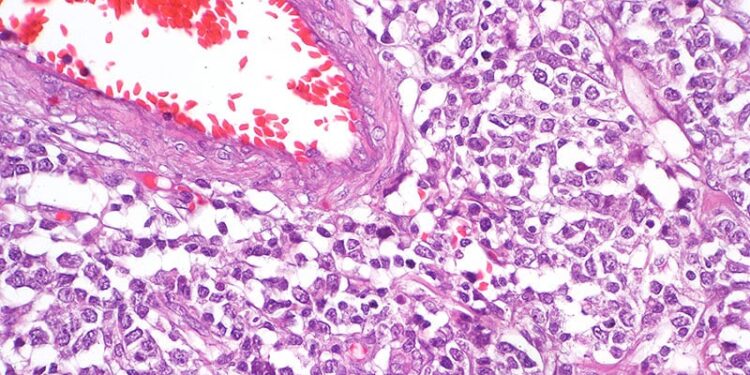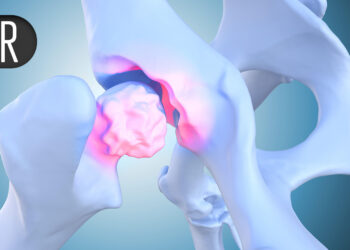The risk for central nervous system (CNS) involvement is small in cases of diffuse large B-cell lymphoma (DLBCL) because only about 5% of patients develop it. But certain high-risk patients are even more likely to get it, and the consequences are likely to be devastating.
“This is a condition [that] has a poor prognosis with high mortality, and the treatments we use are intensified and associated with important side effects,” said hematologist-oncologist Andrés J.M. Ferreri, MD, of IRCCS San Raffaele Scientific Institute in Milan, Italy, in a debate at the 18th International Conference on Malignant Lymphoma (ICML) 2025 in Lugano, Switzerland.
Should patients with DLBCL undergo CNS prophylaxis? Ferreri argued that the answer is yes, “the prophylaxis must be done.” The only question is whether high-dose methotrexate is the appropriate strategy, he said.
But Kate Cwynarski, PhD, a consultant hematologist and honorary associate professor at University College London, in London, England, discouraged colleagues from turning to prophylaxis except — as she herself does — in certain high-risk cases.
Who’s right? “This is an area where there is not one right answer. It’s one of those very nuanced topics. Even within the lymphoma field, there isn’t consensus,” said Joanna M. Rhodes, MD, a hematologist-oncologist with Rutgers Cancer Center and assistant professor at Robert Wood Johnson Medical School, both in New Brunswick, New Jersey, in an interview.
Here’s a closer look at CNS prophylaxis in DLBCL.
What Is CNS Involvement in DLBCL?
There are two types of CNS involvement: primary CNS lymphoma, which arises in the brain or spinal cord, and secondary CNS lymphoma, which occurs when systemic lymphoma spreads to the CNS. The debate in Switzerland — and this article — focuses on secondary CNS relapse.
“Secondary CNS relapse is one of the most devastating things because so few of our agents in our arsenal can cross into the blood-brain barrier,” Rhodes said. “Immunologically, that is a sacred space for a reason. It can be challenging to get therapy in there.”
A 2024 study reported that the median overall survival (OS) after a diagnosis of CNS involvement was just 17.2 months (95% CI, 12-27.5). A 2023 study had a nearly identical median OS, and the 2-year OS was 40%.
Who’s at Risk for CNS Involvement?
High-risk groups include patients with T-cell lymphoma, Burkitt lymphoma, adrenal or kidney involvement, and involvement of ovary, testes, and breast.
Clinicians use the CNS-International Prognostic Index (IPI) scoring system to evaluate risk in patients. “It’s very similar to the [DLBCL] IPI, which takes into account age, stage, number of extra-nodal sites, and LDH [lactate dehydrogenase] elevation,” Rhodes said. “It also takes into account if there is adrenal or kidney involvement since those are two of the areas that we know come with a higher risk of CNS relapse.”
However, “CNS-IPI doesn’t take into a couple of other places where there’s a higher risk of CNS relapse, including ovary and testes, as well as breast. And it doesn’t take into account some of the other biologic features can lead to a higher risk of CNS relapse, such as high-grade lymphomas with bcl-2 rearrangements.”
What Are the Options for CNS Prophylaxis?
There are two options: intrathecal chemotherapy or high-dose systemic methotrexate.
Intrathecal chemotherapy involves directly injecting chemotherapy agents, such as methotrexate, into the cerebrospinal fluid via lumbar puncture. As Rhodes explained, “this is delivered into the spinal fluid, and so that comes with anywhere from four to six lumbar punctures.”
This approach bypasses the blood-brain barrier entirely and delivers medication directly to the CNS, Rhodes said. But it requires multiple procedures and carries procedural risks.
In contrast, systemic methotrexate is given in the hospital and requires a 2- to 5-day stay, said hematologist-oncologist Catherine S.M. Diefenbach, MD, associate professor in the Department of Medicine and director of the Clinical Lymphoma Program at Perlmutter Cancer Center, NYU Langone, New York City, in an interview.
“Adverse effects include mucositis, renal or kidney issues, including elevations in creatinine up until renal failure, as well as cytopenia,” she said.
She added that “methotrexate is very easy to give if you are experienced in administering it. But if you are not experienced in administering it and you do not administer it correctly, there can be significant toxicity.”
What Are the Arguments For and Against CNS Prophylaxis?
The speakers in Switzerland and the two hematologists interviewed for this story agreed that prophylaxis is a good option for high-risk patients. Ferreri went further.
He highlighted a 2021 French study that reported CNS relapse risk at 1 year was 2% in those who received prophylaxis vs 7.1% in those who didn’t. However, the report authors also wrote that “prophylaxis tended to delay CNS relapse rather than prevent it.”
For her part, Cwynarski — who’s worked on several reports with Ferreri — highlighted a 2020 study that “showed no benefit to intercalated high-dose methotrexate, including the high-risk subgroups.”
In addition, she said, “the delivery of intercalated high-dose methotrexate was associated with a significant delay to subsequent R-CHOP [rituximab + cyclophosphamide, doxorubicin, vincristine, prednisone] cycle delivery with an impact on progression-free survival.”
Cwynarski acknowledged a new abstract by Ferreri and colleagues that linked methotrexate to a lower 4-year risk for CNS relapse (2% in nontreated patients vs 0% in treated patients [P = .003] and even larger improvements in high-risk patients). She noted, however, that it’s a single-center study.
What Do Other Hematologists Say?
Rhodes said she prefers intrathecal chemotherapy with methotrexate at the start of treatment in patients who are at a high risk for secondary CNS. For the highest-risk patients, particularly those with testicular or adrenal or renal involvement, “I will often still do high-dose methotrexate at the end as well.”
However, Rhodes noted that her practice has become more selective over time. “I would say that I’m doing less and less of it each year.”
As for Diefenbach, her institution reserves it primarily for cases of T cell, Burkitt, and testicular lymphoma. “We do give it but without a huge amount of supporting data,” she said.
Ferreri disclosed having ties with AbbVie, AstraZeneca, BMS, Genmab, Gilead, Incyte, Juno, Novartis, and various other pharmaceutical companies, as well as the American Society of Hematology, the American Society of Clinical Oncology, and various Italian hematologic and oncologic societies, as well as patents. Cwynarski reported having relationships with AbbVie, Atara, Autolus, BMS, Incyte, Janssen, and others. Rhodes reported having relationships with AbbVie, Acerta, ADC, AstraZeneca, BeiGene, BMS, and others. Diefenbach had no disclosures.
Source link : https://www.medscape.com/viewarticle/cns-prophylaxis-dlbcl-what-clinicians-should-know-2025a1000lru?src=rss
Author :
Publish date : 2025-08-18 10:33:00
Copyright for syndicated content belongs to the linked Source.














